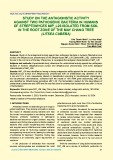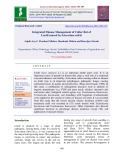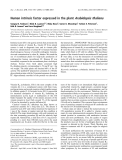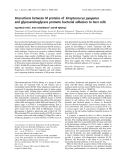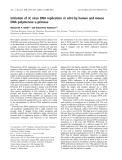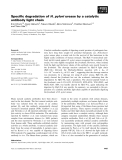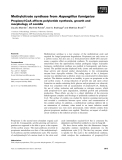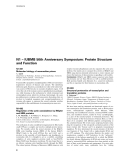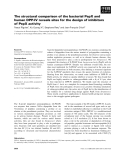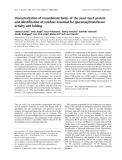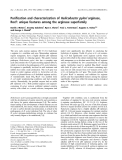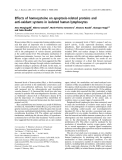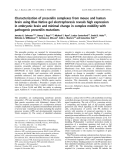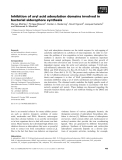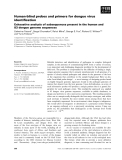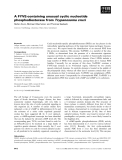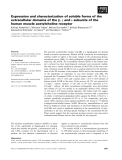
Human pathogens
-
Study on the antagonistic activity against two pathogenic bacteria in humans (Staphylococcus aureus and Streptococcus pneumoniae) of the Streptomyces MIP_L26 (Called MIP_L26), isolated from the soil in the root zone of the May Chang tree; to investigate the biological characteristics of MIP_L26.
 6p
6p  vipanly
vipanly
 28-10-2024
28-10-2024
 0
0
 0
0
 Download
Download
-
Lentil (Lens culinaris L.) is an important edible pulse crop. It is an important source of protein for human diet, plays a vital role as a rotational crop and enhances soil fertility. Sclerotium rolfsii causing collar rot disease on lentil crop is an important polyphagous pathogenic fungus causing substantial losses in quality and productivity (Punja and Grogan, 1988).
 5p
5p  trinhthamhodang11
trinhthamhodang11
 27-04-2021
27-04-2021
 9
9
 3
3
 Download
Download
-
The objective of the present investigation was to isolate and identify the antimicrobial activity showing actinomycetes associated with sponges. Sponges such as Acanthella klethra, Theonella cylendrica, Helicona sp., Auletta sp., and Callyspongia sp. were collected at Sangumal, in Rameswaram island, Ramanathapuram District, Tamil Nadu, India. Isolates of 22 actinomycetes were isolated from sponges. Isolates No. 16 showed high antibacterial and antifungal activity and the isolate was identified as Streptomyces sp.
 8p
8p  cothumenhmong5
cothumenhmong5
 17-05-2020
17-05-2020
 13
13
 1
1
 Download
Download
-
The Nipah and Hendra viruses are highly pathogenic paramyxoviruses that recently emerged from flying foxes to cause serious disease outbreaks in humans and livestock in Australia, Malaysia, Singapore and Bangladesh. Their unique genetic constitution, high virulence and wide host range set them apart from other paramyxoviruses. These characteristics have led to their classification into the new genus Henpaviruswithin the family Para-myxoviridae and to their designation as Biosafety Level 4 pathogens. ...
 10p
10p  tumor12
tumor12
 20-04-2013
20-04-2013
 32
32
 1
1
 Download
Download
-
Intrinsic factor (IF) is the gastric protein that promotes the intestinal uptake of vitamin B12 . Gastric IF from animal sources is used in diagnostic tests and in vitamin pills. However, administration of animal IF to humans becomes disadvantageous because of possible pathogenic transmis-sion and contamination by other B12binders. We tested the use of recombinant plants for large-scale production of pathogen-free human recombinant IF. Human IF was successfully expressed in the recombinant plantArabidopsis thaliana....
 6p
6p  tumor12
tumor12
 20-04-2013
20-04-2013
 37
37
 3
3
 Download
Download
-
Several microbial pathogens have been reported to interact with glycosaminoglycans (GAGs) on cell surfaces and in the extracellularmatrix. Herewe demonstrate thatM protein, a major surface-expressed virulence factor of the human bac-terial pathogen, Streptococcus pyogenes, mediates binding to various forms of GAGs. Hence, S. pyogenesstrains expressing a large number of different types of M proteins bound to dermatan sulfate (DS), highly sulfated fractions of heparan sulfate (HS) and heparin, whereas strains deficient in M protein surface expression failed to interact with these GAGs. ...
 9p
9p  fptmusic
fptmusic
 16-04-2013
16-04-2013
 44
44
 6
6
 Download
Download
-
Host species specificity of the polyomaviruses simian virus 40 (SV40) and mouse polyomavirus (PyV) has been shown to be determined by the host DNA polymerase a-primase complex involved in the initiation of both viral and host DNA replication. Here we demonstrate that DNA repli-cation of the related human pathogenic polyomavirus JC virus (JCV) can be supportedin vitro by DNA polymerase a-primase of either human or murine origin indicating that the mechanism of its strict species specificity differs from that of SV40 and PyV.
 8p
8p  fptmusic
fptmusic
 16-04-2013
16-04-2013
 41
41
 3
3
 Download
Download
-
Catalytic antibodies capable of digesting crucial proteins of pathogenic bac-teria have long been sought for potential therapeutic use. Helicobacter pyloriurease plays a crucial role for the survival of this bacterium in the highly acidic conditions of human stomach. The HpU-9 monoclonal anti-body (mAb) raised againstH. pyloriurease recognized thea-subunit of the urease, but only slightly recognized theb-subunit. However, when isolated both the light and the heavy chains of this antibody were mostly bound to the b-subunit....
 9p
9p  fptmusic
fptmusic
 11-04-2013
11-04-2013
 45
45
 3
3
 Download
Download
-
Methylcitrate synthase is a key enzyme of the methylcitrate cycle and required for fungal propionate degradation. Propionate not only serves as a carbon source, but also acts as a food preservative (E280–283) and pos-sesses a negative effect on polyketide synthesis. To investigate propionate metabolism from the opportunistic human pathogenic fungusAspergillus fumigatus, methylcitrate synthase was purified to homogeneity and charac-terized.
 16p
16p  fptmusic
fptmusic
 11-04-2013
11-04-2013
 24
24
 3
3
 Download
Download
-
Transmissible spongiform encephalopathies (TSE) are fatal neuro-degenerative diseases of humans and animals. The underlying infectious agent, the prion, accumulates not only in the central ner-vous system (CNS) but also in secondary lymphoid organs. I will revisit the role of the immune system in peripheral prion pathogen-esis, while focusing on the mechanisms by which extraneural and extralymphatic prion infectivity develops.
 64p
64p  fptmusic
fptmusic
 11-04-2013
11-04-2013
 36
36
 4
4
 Download
Download
-
X-prolyl dipeptidyl aminopeptidases (X-PDAP) are enzymes catalysing the release of dipeptides from the amino termini of polypeptides containing a proline or an alanine at the penultimate position. Involved in various mam-malian regulation processes, as well as in chronic human diseases, they have been proposed to play a role in pathogenicity forStreptococci.
 10p
10p  awards
awards
 06-04-2013
06-04-2013
 34
34
 4
4
 Download
Download
-
Prion diseases are characterized by the accumulation of a pathogenic mis-folded form of a prion protein (PrP) encoded by the Prnpgene in humans. In the present study in zebrafish, two transcripts and the corresponding genes encoding prion proteins, PrP1 and PrP2, related to human PrP have been characterized with a relatively divergent deduced amino acid sequence, but a well preserved overall organization of structural prion pro-tein motifs.
 14p
14p  awards
awards
 05-04-2013
05-04-2013
 39
39
 2
2
 Download
Download
-
Gas1p is a glycosylphosphatidylinositol-anchored plasma membrane glycoprotein ofSaccharomyces cerevisiaeand is a representative of Family GH72 of glycosidases/transgly-cosidases, which also includes proteins from human fungal pathogens. Gas1p, Phr1-2p from Candida albicansand Gel1p fromAspergillus fumigatushave been shown to be b-(1,3)-glucanosyltransferases required for proper cell wall assembly andmorphogenesis. Gas1p is organized into three modules: a catalytic domain; a cys-richdomain; andahighly O-glycosylated serine-rich region. ...
 11p
11p  awards
awards
 05-04-2013
05-04-2013
 47
47
 4
4
 Download
Download
-
The urea cycle enzyme arginase (EC 3.5.3.1) hydrolyzes L-arginine to L-ornithine and urea. Mammalian arginases require manganese, have a highly alkaline pH optimum and are resistant to reducing agents. The gastric human pathogen,Helicobacter pylori, also has a complete urea cycle and contains therocFgene encoding arginase (RocF), which is involved in the pathogenesis ofH. pyloriinfection. Its arginase is specifically involved in acid resistance and inhibits host nitric oxide production.
 11p
11p  dell39
dell39
 03-04-2013
03-04-2013
 50
50
 5
5
 Download
Download
-
Homocysteine (Hcy) is anonprotein-forming sulphur amino acid that plays an important role in remethylation and trans-sulphuration processes. In recent years, it has been suggested that increased levels of plasma Hcy may play a role in the pathogenesis of various diseases, particularly at the cardiovascular level. The pathogenic mechanism of hyperhomocysteinemia, however, has not been clarified.
 6p
6p  dell39
dell39
 03-04-2013
03-04-2013
 54
54
 3
3
 Download
Download
-
The presenilin proteins are required for intramembrane cleavage of a subset of type 1 membrane proteins including the Alzheimer’s disease amyloid precursor protein. Previous studies indicate presenilin proteins form enzymatically act-ive high molecular mass complexes consisting of hetero-dimers of N- and C-terminal fragments in association with nicastrin, presenilin enhancer-2 and anterior pharynx defective-1 proteins.
 11p
11p  dell39
dell39
 03-04-2013
03-04-2013
 34
34
 4
4
 Download
Download
-
Aryl acid adenylation domains are the initial enzymes for aryl-capping of catecholic siderophores in a plethora of microorganisms. In order to over-come the problem of iron acquisition in host organisms, siderophore bio-synthesis is decisive for virulence development in numerous important human and animal pathogens.
 11p
11p  dell39
dell39
 27-03-2013
27-03-2013
 28
28
 3
3
 Download
Download
-
Reliable detection and identification of pathogens in complex biological samples, in the presence of contaminating DNA from a variety of sources, is an important and challenging diagnostic problem for the development of field tests. The problem is compounded by the difficulty of finding a single, unique genomic sequence that is present simultaneously in all genomes of a species of closely related pathogens and absent in the genomes of the host or the organisms that contribute to the sample background. ...
 11p
11p  dell39
dell39
 27-03-2013
27-03-2013
 35
35
 4
4
 Download
Download
-
Cyclic-nucleotide-specific phosphodiesterases (PDEs) are key players in the intracellular signaling pathways of the important human pathogen Trypano-soma cruzi. We report herein the identification of an unusual PDE from this protozoal organism. This enzyme, TcrPDEC, is a member of the class I PDEs, as determined from the presence of a characteristic signature sequence and from the conservation of a number of functionally important amino acid residues within its catalytic domain.
 11p
11p  dell39
dell39
 27-03-2013
27-03-2013
 40
40
 2
2
 Download
Download
-
The nicotinic acetylcholine receptor (AChR) is a ligand-gated ion channel found in muscles and neurons. Muscle AChR, formed by five homologous subunits (a2bcdora2bce), is the major antigen in the autoimmune disease, myasthenia gravis (MG), in which pathogenic autoantibodies bind to, and inactivate, the AChR.
 12p
12p  inspiron33
inspiron33
 25-03-2013
25-03-2013
 40
40
 2
2
 Download
Download
CHỦ ĐỀ BẠN MUỐN TÌM








